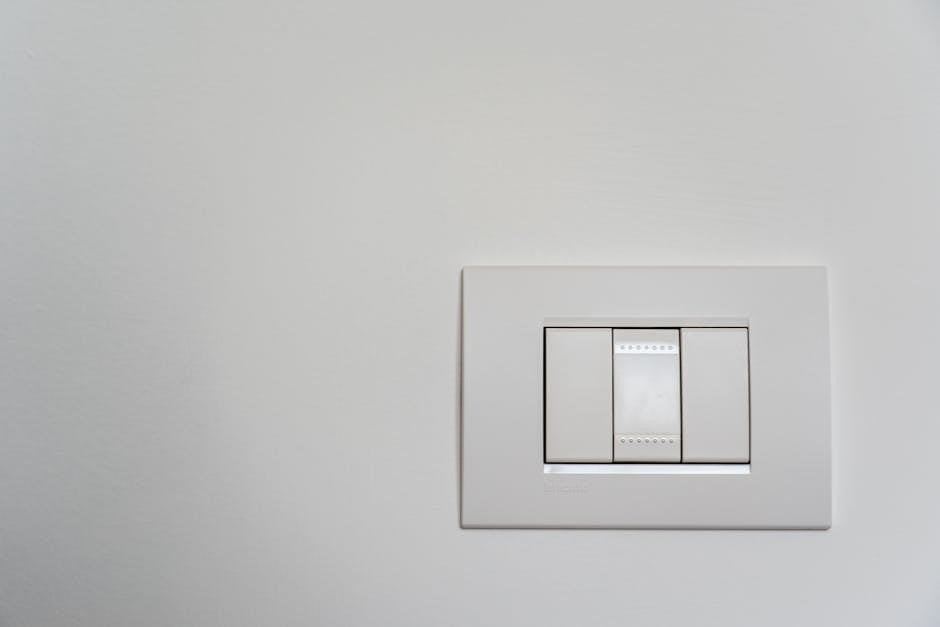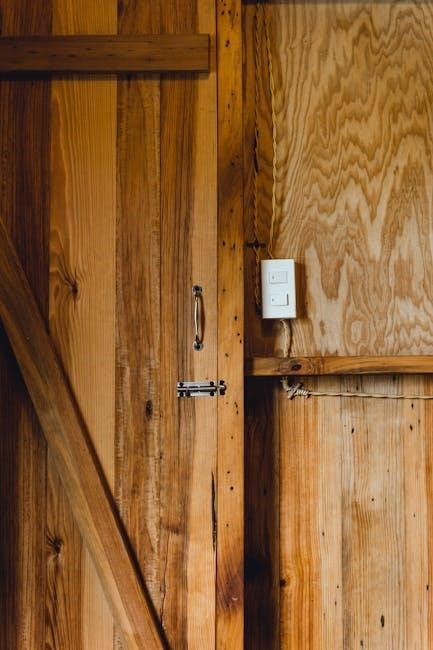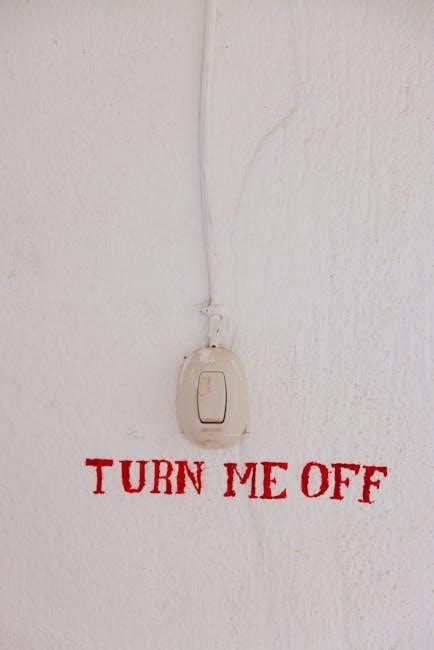
Experience the convenience of Honeywell Light Switch Timer, a programmable timer that enhances home automation․ It offers customizable schedules, energy efficiency, and seamless integration with various lighting systems, providing a modern solution for smart living․
Overview of Honeywell Light Switch Timer
The Honeywell Light Switch Timer is a versatile and user-friendly device designed to enhance home automation․ It allows users to program up to 7 on-and-off schedules per week, offering flexibility for different lighting needs․ Compatible with incandescent and halogen lighting systems, this timer provides energy efficiency and convenience․ Key features include random operation to simulate occupancy and customizable settings tailored to daily routines․ Installation requires a neutral wire, and it can be integrated with various lighting configurations․ Available in models like the RPLS740B, it is a popular choice for homeowners seeking to modernize their lighting control; This timer is ideal for those looking to add smart functionality without replacing bulbs․
Benefits of Using a Programmable Light Switch Timer
Using a programmable light switch timer offers numerous benefits, including enhanced convenience, energy savings, and improved security․ It allows users to create customized schedules, ensuring lights turn on and off automatically, which can deter intruders by simulating occupancy․ This feature is especially useful for homes that are unoccupied for extended periods․ Additionally, programmable timers reduce energy waste by automatically turning off lights when not needed, lowering utility bills․ They also provide flexibility, enabling users to adjust settings based on daily routines or seasonal changes․ Compatibility with various lighting systems, including incandescent and halogen, makes it a versatile solution for modern homes․
Understanding the Features of Honeywell Light Switch Timer
The Honeywell Light Switch Timer combines programmable scheduling, energy efficiency, and customizable settings, offering users precise control over lighting systems for enhanced convenience and adaptability in any home environment․
Key Features of Honeywell Light Switch Timer
The Honeywell Light Switch Timer offers a range of innovative features designed for convenience and efficiency․ It includes programmable scheduling, allowing users to set custom on/off times for their lights․ The timer is equipped with a touch screen or button interface for easy navigation․ It also supports multiple scheduling options, such as daily, weekly, or one-time programming․ Additionally, it is compatible with various lighting systems, including LED, incandescent, and fluorescent lights․ The timer also features a battery backup to retain settings during power outages․ With its energy-saving capabilities and user-friendly design, the Honeywell Light Switch Timer is a versatile solution for modern homes․
Compatibility with Different Lighting Systems
The Honeywell Light Switch Timer is designed to work seamlessly with a variety of lighting systems, ensuring versatility for different setups․ It is compatible with LED, incandescent, and halogen bulbs, as well as energy-efficient options like CFLs․ The timer also supports dimmable LEDs, allowing for smooth transitions between brightness levels․ Additionally, it can integrate with smart home systems, enabling voice control through platforms like Alexa or Google Home․ This wide compatibility ensures that the Honeywell timer can adapt to most residential lighting configurations, making it a flexible solution for modern homes․ Its universal design minimizes compatibility concerns, providing a reliable fit for various electrical systems․

Preparation for Installation
Before installing the Honeywell Light Switch Timer, ensure the power is off at the main electrical panel and verify with a voltage tester․ Gather tools like screwdrivers, pliers, and electrical tape․ Understand your wiring setup by identifying live, neutral, and ground wires, and document connections․ Follow Honeywell’s specific instructions for compatibility and preparation․ Clean the area around the switch to prevent dust interference․ Check local electrical codes and consider consulting a licensed electrician if unsure․ Plan the installation steps to ensure a smooth process․ Having all materials ready and a clear workspace will help achieve a safe and successful installation․
Tools and Materials Required
To install the Honeywell Light Switch Timer, you will need specific tools and materials․ Start with a flathead screwdriver for removing the old switch cover and a Phillips screwdriver for wiring connections․ Pliers and wire strippers are essential for handling wires safely․ A voltage tester ensures the power is off before starting․ Additionally, gather electrical tape, mounting screws, and wall anchors for secure installation․ A drill may be necessary for drilling holes if needed․ Ensure you have the timer unit itself, along with any extra wiring connectors․ Having these tools and materials ready will streamline the installation process and ensure safety․ Proper preparation prevents delays and ensures a successful setup․
Understanding Electrical Connections
Understanding electrical connections is crucial for safely installing the Honeywell Light Switch Timer․ Begin by identifying the wires in your existing setup․ Typically, you’ll find a line wire (live), load wire (to the light), and ground wire․ For single-pole switches, the connections are straightforward, while multi-switch setups may require additional wiring․ Always turn off the power at the circuit breaker before working․ Use a voltage tester to confirm no electricity is present․ Correctly connecting the wires ensures proper timer function and safety․ Misconnecting wires can cause malfunctions or hazards․ Refer to the timer’s wiring diagram for specific instructions tailored to your system․ Proper electrical understanding is key to a successful installation․
Installation Steps for Honeywell Light Switch Timer
Install the Honeywell Light Switch Timer by turning off power, testing wires, and mounting the timer․ Connect wires securely, following the diagram, and restore power to test functionality․

Connecting the Wires to the Timer
Start by turning off the power to the circuit at the breaker box and verifying it with a voltage tester․ Identify the wires: load (to lights), line (from power source), neutral, and ground․ Connect the line wire to the “LINE” terminal on the timer, and the load wire to the “LOAD” terminal․ The neutral wire connects to the “NEUTRAL” or “COMMON” terminal, if applicable․ Secure the ground wire to the timer’s grounding terminal․ Follow the wiring diagram provided with the Honeywell timer for specific connections․ Ensure all wires are tightly secured to prevent loose connections, which can cause malfunctions․ Double-check all connections before restoring power․

Mounting the Timer Switch to the Wall
After connecting the wires, carefully remove any protective covering from the timer’s backside․ Align the Honeywell timer switch with the electrical box, ensuring it is level․ Use the provided screws to secure the timer to the wall, tightening them firmly but avoiding overtightening, which could damage the device․ Once mounted, check that the timer sits flush against the wall and the faceplate is properly aligned․ Install the wall plate over the timer, ensuring it fits securely․ Tighten the screws gently to avoid stripping the threads․ Finally, restore the power and test the timer to ensure it functions correctly․ Proper mounting ensures reliable operation and a professional appearance․

Finalizing the Installation
Once the timer is mounted and wired, restore power to the circuit by switching the breaker or replacing the fuse․ Test the timer by toggling the switch and observing the lights to ensure proper operation․ Check that all connections are secure and tighten any loose wires․ Verify that the timer’s faceplate is evenly aligned and securely fastened․ Clean any debris or dust from the timer’s surface for optimal performance․ Double-check the installation against the manufacturer’s instructions to ensure compliance․ Finally, label the timer switch for easy identification and future reference․ A successful installation ensures reliable and efficient control of your lighting system․

Programming the Honeywell Light Switch Timer
Programming the Honeywell Light Switch Timer involves setting specific on/off times for your lights․ Start by setting the current time and date to ensure accurate scheduling․ Use the buttons to create a daily schedule, with options for multiple on/off events․ For energy efficiency, set precise timings down to the minute․ Some models allow integration with smart home systems for enhanced control․ Refer to the user manual or online guides for step-by-step instructions․ Programming is straightforward, enabling you to automate your lighting and save energy effortlessly․
Setting Up Basic Schedules
Setting up basic schedules on the Honeywell Light Switch Timer is simple and straightforward․ Begin by pressing the “SET” button to enter programming mode․ Use the arrow keys to set the current time and date, ensuring accuracy for your schedules․ Next, press the “PROG” button to create a new schedule․ Choose the day(s) of the week and the specific time you want the lights to turn on or off․ You can set up to multiple on/off events per day․ Once configured, press “SAVE” to store your settings․ This feature allows you to automate your lighting routine, reducing manual adjustments and saving energy․ Always refer to the manual for detailed guidance․
Programming Advanced Schedules
Programming advanced schedules on the Honeywell Light Switch Timer allows for greater customization and flexibility․ Use the “PROG” button to access advanced settings, where you can create complex on/off patterns․ For example, you can set random start times for added security or program different schedules for weekends versus weekdays․ Additionally, you can create custom scenes, such as dimming lights for movie nights or brightening them for parties․ To ensure accuracy, test your advanced schedules before finalizing them․ This feature is ideal for homeowners who want tailored lighting solutions that adapt to their unique lifestyle․ Refer to the manual for step-by-step guidance on advanced programming․

Troubleshooting Common Issues

Identify and resolve issues like timer malfunction or display problems․ Check power supply, wiring connections, and compatibility․ Reset the timer or update firmware if necessary․
Resolving Connection Problems
Connection issues with the Honeywell Light Switch Timer can often be resolved by checking the wiring․ Ensure all wires are securely connected to the correct terminals․ Verify that the timer is properly installed and grounded․ If the timer is not responding, check the power supply and confirm the circuit breaker is on․ Loose connections can cause malfunction, so tighten any wires․ If the issue persists, consult the user manual or reset the timer by turning the power off and on․ For complex wiring setups, consider consulting a licensed electrician․ Regularly inspecting connections can prevent future problems and ensure smooth operation․
Fixing Programming Errors
If you encounter programming errors with your Honeywell Light Switch Timer, start by resetting the device․ Turn off the power at the circuit breaker, wait a few seconds, and then restore power․ This often resolves glitches․ Review your programmed schedules to ensure they were entered correctly, as typos or incorrect settings can cause issues․ Check for firmware updates, as newer versions may fix bugs affecting programming․ Verify that all electrical connections are secure and properly insulated․ If error codes appear, consult the user manual or Honeywell’s support resources for specific solutions․ If problems persist, contact customer support or a licensed electrician for assistance․
Maintenance and Safety Tips
Regularly clean the timer to prevent dust buildup and ensure smooth operation․ Inspect wires for damage and tighten connections to avoid electrical hazards․ Always turn off power before servicing the device․ Schedule annual checks to maintain functionality and safety․ Avoid overloading the switch with too many devices․ Follow manufacturer guidelines for replacement parts to ensure compatibility and safety․ Keep the timer away from direct sunlight and moisture to prevent malfunction․ Never attempt repairs without proper tools and knowledge․ If unsure, consult a licensed electrician for assistance․ Always prioritize safety when working with electrical systems․
Regular Maintenance for Optimal Performance
Regular maintenance is crucial to ensure your Honeywell light switch timer operates efficiently․ Start by dusting the exterior and internal components with a soft, dry cloth to prevent dust buildup, which can cause overheating․ Check the wires for any signs of wear or damage and ensure all connections are secure․ Replace any worn-out parts immediately to avoid electrical issues․ Refer to the Honeywell manual for specific maintenance recommendations tailored to your timer model․ Performing these checks quarterly can prevent unexpected malfunctions and extend the lifespan of your timer․ Always turn off the power supply before carrying out any maintenance tasks to ensure safety․
Safety Precautions When Working with Electrical Systems
When working with your Honeywell light switch timer, always prioritize safety to avoid electrical hazards․ Ensure the power supply is turned off at the circuit breaker or fuse box before starting any installation or maintenance․ Use a voltage tester to confirm no electricity is present․ Avoid DIY repairs without proper tools or knowledge, as this can lead to dangerous malfunctions․ If unsure, consult a licensed electrician․ Never touch electrical components with wet hands or while standing on a damp surface․ Wear insulated gloves and safety goggles for added protection․ Keep children and pets away from the work area․ Always follow the manufacturer’s guidelines and local electrical codes to ensure safe and correct installation․

Customizing Your Honeywell Light Switch Timer
Customize your Honeywell light switch timer to suit your lifestyle and preferences․ Adjust settings for personalized lighting experiences, energy efficiency, and seamless smart home integration․

Integrating with Smart Home Systems
Integrate your Honeywell light switch timer with popular smart home systems like Samsung SmartThings or Wink for enhanced control․ Use voice commands via Amazon Alexa or Google Assistant to manage your lighting․ Ensure compatibility by checking Honeywell’s list of supported systems․ Download the respective apps to pair your timer with your smart home hub․ Set up custom scenes and routines to automate lighting based on your schedule or preferences․ This integration allows remote access and seamless operation, making your home smarter and more energy-efficient․ Follow the manufacturer’s instructions for pairing and configuring the timer with your chosen smart home platform․
Adjusting Settings for Energy Efficiency
Optimize energy usage by adjusting your Honeywell light switch timer to align with your daily routines and natural light availability․ Program the timer to turn lights off during daylight hours or when rooms are unoccupied․ Use the built-in astronomic feature to synchronize lighting with sunrise and sunset times; Adjust schedules seasonally to account for changing daylight patterns․ Enable energy-saving modes to reduce unnecessary illumination․ Customize settings to ensure lights are only on when needed, reducing energy waste and lowering utility bills․ Access these settings through the timer’s menu, ensuring your lighting system operates efficiently while maintaining comfort and convenience․
Thank you for following the Honeywell Light Switch Timer guide․ This timer offers programmable scheduling and energy efficiency, enhancing your home’s convenience and reducing energy waste․ Enjoy the benefits of lighting control!
Final Thoughts on Honeywell Light Switch Timer
Encouragement to Explore More Features
Take the time to explore the advanced features of your Honeywell Light Switch Timer, as they offer even greater convenience and efficiency․ Experiment with custom schedules, voice control through smart home systems, and energy-saving settings to tailor the timer to your lifestyle․ Discover how integrating with other smart devices can create a seamless home automation experience․ Regularly update your schedules to reflect seasonal changes or new routines․ Don’t hesitate to explore the timer’s full potential—its versatility can significantly enhance your daily life․ By diving deeper into its capabilities, you’ll unlock new ways to save time and energy while enjoying a smarter home․